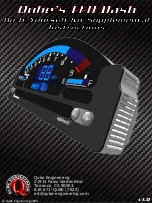
If Your Engine Overheats
6. Look for any obvious coolant leaks,
such as a split radiator hose.
Everything is still extremely hot,
so use caution. If you find a leak, it
must be repaired before you
continue driving (see
Emergency
Towing
on page
238
).
7. If you don't find an obvious leak,
check the coolant level in the
radiator reserve tank (see page
120
). If the level is below the
M I N mark, add coolant to halfway
between the M I N and MAX marks.
8. If there was no coolant in the
reserve tank, you may also have to
add coolant to the radiator. Let the
engine cool down until the reading
reaches the middle of the
temperature gauge, or lower,
before checking the radiator.
9. Using gloves or a large heavy
cloth, turn the radiator cap
counterclockwise, without pushing-
down, to the first stop. This
releases any remaining pressure in
the cooling system. After the
pressure releases, push down on
the cap and turn it until it comes
off.
Taking Care of the Unexpected
Removing the radiator cap
while the engine is hot can
cause the coolant to spray out,
seriously scalding you.
Always let the engine and
radiator cool down before
removing the radiator cap.
Main Menu
Table of Contents
▲
▼
















































